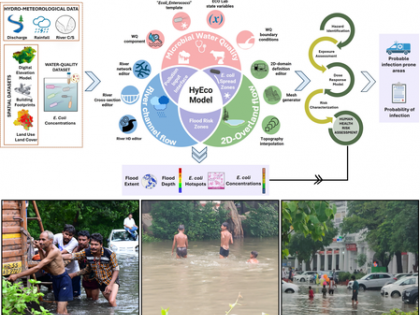IIT Roorkee's new tool to predict how floods spread disease in cities
By IANS | Updated: August 20, 2025 16:10 IST2025-08-20T16:00:55+5:302025-08-20T16:10:14+5:30
New Delhi, Aug 20 Researchers at the Indian Institute of Technology (IIT) Roorkee have developed HyEco -- a ...

IIT Roorkee's new tool to predict how floods spread disease in cities
New Delhi, Aug 20 Researchers at the Indian Institute of Technology (IIT) Roorkee have developed HyEco -- a first-of-its-kind integrated flood-water quality modelling platform which shows how potential disease-causing microbes can travel in floodwaters and where people are most at risk of getting affected.
This novel framework, which also predicts how urban flood waters will spread across a city, was tested during the 2023 Delhi floods.
The results were alarming; over 60 per cent of flooded areas were in the high to very high danger zones, and harmful bacteria (E. coli) in the water were found to be hundreds of thousands of times above safe limits.
Children, in particular, faced infection risks more than double the internationally accepted safety levels when playing in floodwaters.
Floodwaters in many Indian cities mix with untreated sewage and industrial waste, creating a toxic mix that can lead to outbreaks of diarrhoea, cholera, and other dangerous water-borne diseases.
HyEco can help authorities see these threats in advance, identify "health danger hotspots," and take quick action to protect people, for example, by improving sewage treatment, cleaning drains before monsoons, warning residents through SMS alerts, and using advanced water cleaning methods.
"Floods don't just damage buildings; they can trigger silent health crises. HyEco gives us the power to see where the danger will be highest, so action can be taken before it's too late," said Prof. Mohit P. Mohanty, Department of Water Resources Development and Management, IIT Roorkee.
"This research is a perfect example of science serving society.
HyEco is designed to be used not just in India but in flood-prone cities worldwide, from Mumbai to Manila, Jakarta to New Orleans, offering an innovative, science-based solution to reduce the risk of waterborne diseases after floods.
The research supports key government missions, such as the National Mission for Clean Ganga, Swachh Bharat Mission, National Disaster Management Plan, and the National Health Mission.
It also helps meet several United Nations Sustainable Development Goals (SDGs), including SDG 3 (good health and well-being), SDG 6 (clean water and sanitation), SDG 11 (sustainable cities and communities), and SDG 13 (climate action).
Disclaimer: This post has been auto-published from an agency feed without any modifications to the text and has not been reviewed by an editor
Open in app